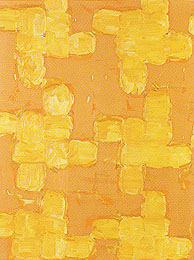|
The medium that supports the tableau painted by Takashi Yamauchi is a canvas made from various printed cloths, which are normally used for curtain, clothes, and tablecloths. By looking at the painting closely, the viewer eventually learns that the painted patterns are, in fact, a series of magnified patterns, which matches the ones on the canvas.
Art, in this century, has taken its time to explore the many ways to handle a shape ( image or figure ). However, this problem of shape inevitably poses the question about its supporting medium. Clement Greenberg predicted that painting is absolutely subject to the shape of the supporting canvas: " the tacked-up canvas already exists as a picture". Donald Judd exposed this role of the canvas later in the process of the reduction to the plane in a painting.
On the one hand, Greenberg denies representational illusion in a painting, but not the existence of optical illusion. He seeks optical illusion in a painting. However, illusion, which is not representational but purely optical, occurs more readily if the painted shape determinantly exists on the surface of the support. It was necessary to make the shape independent of its support. Painters, such as Pollock and Stella, achieved this independence in the painting. As Judd points out, the painted shape, in most cases, would exist behind, rather than on the surface, of the support, evoking the sense of representational illusion.
Yamauchi deals with the problem of shape and support. How else would a painter born in 1975 deal with painting? His solution is rather simple and unique:
- To give the canvas as the support a systematic shake or noise - that is, to set up a canvas using patterned cloth. ( Canvas, and other supporting elements of Yamauchi are ready-made objects. Ready-made objects are noise to the system.)
- To create shapes based on the original canvas with patterns.
- The pattern of the canvas is reproduced and painted on the canvas as a shape in a simple way, which could also be called a quasi-tautology. ( A cynical approach in a sense that "a shape originating in the support is, in fact, tautological." )
The painted shape systematically and visually amplifies the noise. It exists clearly on the surface of the support. The physical hierarchy is made clear through two amplifications. Thus, a purely optical illusion is created in a very simple process.
Bibliography:
Donald Judd,"Specific Objects"1965
Crement Greenberg,"Modernist painting"1960
Crement Greenberg,"After Abstract Expressionism"1962
|
|

